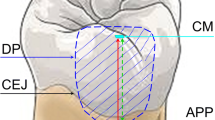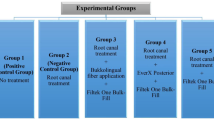Abstract
Objective
To compare the different restoration types of primary teeth to determine which type is appropriate for extensive caries of primary molars and incisors based on mechanical properties.
Materials and methods
A total of 160 primary teeth were evaluated in this study, including 80 incisors and 80 molars. Each category was divided into four groups: the control group, composite resin group, pre-veneered stainless steel crown (stainless steel crown) group, and zirconia crown group. Compressive strength test and fatigue strength test were performed.
Results
The compressive strength and fatigue strength of the composite resin group were significantly decreased compared with the control group (P < 0.05). The prefabricated crown groups showed increased fatigue and compressive strength compared with the control group, and the zirconia crown group was higher than that of the pre-veneered stainless steel crown group (P < 0.05). The zirconia crown group was less than the stainless steel crown group (P < 0.05) in the compressive strength but more than the stainless steel crown group (P < 0.05) in the fatigue strength.
Conclusions
The compressive strength and fatigue strength of crown restoration were superior to that of the composite resin filling. The fatigue strength of the zirconia crown also performed better than the pre-veneered stainless steel crown and the stainless steel crown. The compressive strength of the zirconia crown was less than that of the stainless steel crown.
Clinical relevance
The zirconia crown is a new restoration method for primary teeth that may be commonly applied in clinical practice.





Similar content being viewed by others
References
Bardini G, Casula L, Ambu E, Musu D, Mercadè M, Cotti E (2021) A 12-month follow-up of primary and secondary root canal treatment in teeth obturated with a hydraulic sealer. Clin Oral Invest 25(5):2757–2764. https://doi.org/10.1007/s00784-020-03590-0
Maguire A, Clarkson JE, Douglas GV, Ryan V, Homer T, Marshman Z, McColl M, Wilson N, Vale L, Robertson M, Abouhajar A, Holmes RD, Freeman R, Chadwick B, Deery C, Wong F, Innes NP (2020) Best-practice prevention alone or with conventional or biological caries management for 3- to 7-year-olds: the FiCTION three-arm RCT. Health Technol Asses (Winchester, England) 24(1):1–174. https://doi.org/10.3310/hta24010
Santamaría RM, Abudrya MH, Gül G, Mourad MS, Gomez GF, Ferreira Zandona AG (2020) How to Intervene in the Caries Process: Dentin Caries in Primary Teeth. Caries Res 54(4):306–323.https://doi.org/10.1159/000508899
Loch C, Ludwig Vuuren JV, Duncan WJ, Boyd DH, Lyndie Page AF (2021) Ultrastructure and properties of primary carious molars treated using the Hall technique. Int J Paediatr Dent 31(3):290–298. https://doi.org/10.1111/ipd.12681
Gümüş H, Delikan E (2021) The effect of sonic activation of irrigant on postoperative pain after root canal treatment in primary molar teeth: a randomized, clinical study. Clin Oral Invest 25(1):363–370. https://doi.org/10.1007/s00784-020-03687-6
Zelic K, Vukicevic A, Jovicic G, Aleksandrovic S, Filipovic N, Djuric M (2015) Mechanical weakening of devitalized teeth: three-dimensional finite element analysis and prediction of tooth fracture. Int Endod J 48:850–863. https://doi.org/10.1111/iej.12381
Maciel Martins CR, de Ventura MA, Carvalho AP, Afonso Pereira RM, Bresolin CR, Volpi Mello-Moura AC, PettorossiImparato JC (2021) Photodynamic therapy associated final irrigation in root canals of the primary teeth. Photodynamic therapy 33:102182. https://doi.org/10.1016/j.pdpdt.2021.102182
Seale NS (2002) The use of stainless steel crowns. Pediatr Dent 24(5):501–505
Seminario AL, Garcia M, Spiekerman C, Rajanbabu P, Donly KJ, Harbert P (2019) Survival of zirconia crowns in primary maxillary incisors at 12-, 24- and 36-month follow-Up. Pediatr Dent 41(5):385–390
Mathew MG, Samuel SR, Soni AJ, Roopa KB (2020) Evaluation of adhesion of Streptococcus mutans, plaque accumulation on zirconia and stainless steel crowns, and surrounding gingival inflammation in primary molars: randomized controlled trial. Clin Oral Invest 24(9):3275–3280. https://doi.org/10.1007/s00784-020-03204-9
Walia T, Salami AA, Bashiri R, Hamoodi OM, Rashid F (2014) A randomized controlled trial of three aesthetic full-coronal restorations in primary maxillary teeth. Eur J Paediatr Dent 15(2):113–118
Zimmerman JA, Feigal RJ, Till MJ, Hodges JS (2009) Parental attitudes on restorative materials as factors influencing current use in pediatric dentistry. Pediatr Dent 31(1):63–70
Espelid I, Cairns J, Askildsen JE, Qvist V, Gaarden T, Tveit AB (2006) Preferences over dental restorative materials among young patients and dental professionals. Eur J Oral Sci 114(1):15–21. https://doi.org/10.1111/j.1600-0722.200.00282.x
Kist S, Stawarczyk B, Kollmuss M, Hickel R, Huth KC (2019) Fracture load and chewing simulation of zirconia and stainless-steel crowns for primary molars. Eur J Oral Sci 127(4):369–375. https://doi.org/10.1111/eos.12645
Ram D, Fuks AB, Eidelman E (2003) Long-term clinical performance of esthetic primary molar crowns. Pediatr Dent 25(6):582–584
Dean JA, Mack RB, Fulkerson BT, Sanders BJ (2002) Comparison of electrosurgical and formocresol pulpotomy procedures in children. Int J Paediatr Dent 12(3):177–182. https://doi.org/10.1046/j.1365-263x.2002.00355.x
Clark L, Wells MH, Harris EF, Lou J (2016) Comparison of amount of primary tooth reduction required for anterior and posterior zirconia and stainless steel crowns. Pediatr Dent 38(1):42–46
Waggoner WF (2015) Restoring primary anterior teeth: updated for 2014. Pediatr Dent 37(2):163–170
Schindler HJ, Stengel E, Spiess WE (1998) Feedback control during mastication of solid food textures–a clinical-experimental study. J Prosthet Dent 80(3):330–336. https://doi.org/10.1016/s0022-3913(98)70134-9
Braun S, Hnat WP, Freudenthaler JW, Marcotte MR, Hönigle K, Johnson BE (1996) A study of maximum bite force during growth and development. Angle Orthod 66(4):261–264. https://doi.org/10.1043/0003-3219
Planells del Pozo P, Fuks AB (2014) Zirconia crowns: an esthetic and resistant restorative alternative for ECC affected primary teeth. J Clin Pediatr Dent 38(3):193–195. https://doi.org/10.17796/jcpd.38.3.0255q84jt2851311
Ashima G, Sarabjot KB, Gauba K, Mittal HC (2014) Zirconia crowns for rehabilitation of decayed primary incisors: an esthetic alternative. J Clin Pediatr Dent 39(1):18–22. https://doi.org/10.17796/jcpd.39.1.t6725r5566u4330g
Salami A, Walia T, Bashiri R (2015) Comparison of parental satisfaction with three tooth-colored full-coronal restorations in primary maxillary incisors. J Clin Pediatr Dent 39(5):423–428. https://doi.org/10.17796/1053-4628-39.5.423
Güçlü ZA, Çalışkan S, Efe Z, Doğan S (2020) Can zirconia crowns be the first restorative choice after endodontic treatment of primary teeth? Int J of Clin Pract 75(12):e14888. https://doi.org/10.1111/ijcp.14888
Yanover L, Waggoner W, Kupietzky A, Moskovitz M, Tickotsky N (2020) Parental and Dentist Satisfaction with Primary Anterior Zirconia Crowns: A Case Series Analysis. Children (Basel, Switzerland) 8(6). https://doi.org/10.3390/children8060451
Townsend JA, Knoell P, Yu QZ, Zhang JF, Wang YP, Zhu H, Beattie S, Xu XM (2014) In vitro fracture resistance of three com -mercially available zirconia crowns for primary molars. Pediatr Dent 36(5):125–129
Abukabbos H, Tomar S, Guelmann M (2018) Cost estimates for bioactive cement pulpotomies and crowns in primary molars. Pediatr Dent 40(1):51–55
Simsek H, Derelioglu S (2016) In Vitro Comparative Analysis of Fracture Resistance in Inlay Restoration Prepared with CAD-CAM and Different Systems in the Primary Teeth. BioMed Res Int 2016:4292761. https://doi.org/10.1155/2016/4292761
Cazaux SL, Hyon I, Prud’homme T, Trutaud SD (2017) Twenty-nine-month follow-up of a paediatric zirconia dental crown. BMJ Case Rep 14:1–6. https://doi.org/10.1136/bcr-2017-219891
Lee JH (2018) Guided tooth preparation for a pediatric zirconia crown. J Am Dent Assoc 149(3):202-208. e2. https://doi.org/10.1016/j.adaj.2017.08.048
Holsinger DM, Wells MH, Scarbecz M, Donaldson M (2016) Clinical evaluation and parental satisfaction with pediatric zirconia anterior crowns. Pediatr Dent 38(3):192–197
El Shahawy OI, ÓConnell AC (2016) Successful restoration of severely mutilated primary incisors using a novel method to retain zirconia crowns: two year results. J Clin Pediatr Dent 40(6):425–430. https://doi.org/10.17796/1053-4628-40.6.425
Esquivel-Upshaw JF, Anusavice KJ, Yang MC, Lee RB (2001) Fracture resistance of all-ceramic and metal-ceramic inlays. Int J Prosthodont 14(2):109–144
Kamegai T, Tatsuki T, Nagano H, Mitsuhashi H, Kumeta J, Tatsuki Y, Inaba D (2005) A determination of bite force in northern Japanese children. Eur J Orthod 27:53–57. https://doi.org/10.1093/ejo/cjh090
Duarte Gavião MB, Raymundo VG, Rentes AM (2007) Masticatory performance and bite force in children with primary dentition. Braz Oral Res 21:146–152. https://doi.org/10.1590/s1806-83242007000200009
Zarone F, Sorrentino R, Traini T, Lorio DD, Caputi S (2007) Fracture resistance of implant-supported screwversus cement-retained porcelain fused to metal single crowns: SEM fractographic analysis. Dent Mater 23(3):296–301. https://doi.org/10.1016/j.dental.2005.10.013
Beattie S, Taskonak B, Jones J, Chin J, Sanders B, Tomlin A, Weddell J (2011) Fracture resistance of 3 types of primary esthetic steel crowns. J Can Dent Assoc 77:b90
Shirakura A, Lee H, Geminiani A, Ercoli C, Feng CY (2009) The influence of veneering porcelain thickness of all-ceramic and metal ceramic crowns on failure resistance after cyclic loading. J Prosthet Dent 101(2):119–127. https://doi.org/10.1016/S0022-3913(09)60006-8
Rammelsberg P, Eickemeyer G, Erdelt K, Pospiech P (2000) Fracture resistance of posterior metalfree polymer crowns. J Prosthet Dent 84:303–303. https://doi.org/10.1067/mpr.2000.108068
Attin T, Koidl U, Buchalla W, Schaller HG, Kielbassa AM, Hellwig E (1997) Correlation of microhardness and wear in differently eroded bovine dental enamel. Arch Oral Biol 42(3):243–250. https://doi.org/10.1016/0003-9969(06)00073-2
Mitov G, Heintze SD, Walz S, Woll K, Muecklich F, Pospiech P (2012) Wear behavior of dental Y-TZP ceramic against natural enamel after different fifinishing procedures. Dent Mater 28(8):909–918. https://doi.org/10.1016/j.dental.2012.04.010
Kessler A, Kapor S, Erdelt K, Hickel H, Edelhoff D, Syrek A, Güth JF, Kühnisch J (2021) Two-body wear and fracture behaviour of an experimental paediatric composite crown in comparison to zirconia and stainless steel crowns dependent on the cementation mode. Dent Mater 37(2):264–271. https://doi.org/10.1016/j.dental.2020.11.010
Diener V, Polychronis G, Erb J, Zinelis S, Eliades T (2019) Surface, microstructural, and mechanical characterization of prefabricated pediatric zirconia crowns. Materials (Basel) 12(20):3280. https://doi.org/10.3390/ma12203280
Acknowledgements
The authors gratefully acknowledge the State Key Laboratory of Military Stomatology of the Fourth Military Medical University.
Funding
This study was funded by the Independent Research Project of the State Key Laboratory of Military Stomatology (2019ZA06) and the Special Project of the National Clinical Research Center for Oral Diseases (LCA202010).
Author information
Authors and Affiliations
Contributions
All authors contributed to the study conception and design. Junhui Wang and Xiaojing Wang participated in all parts of the experiments. Baize Zhang participated in most of the experiments. Material preparation and data collection were performed by Yujiang Chen and Lulu Wang. The teeth used in the experiment were collected by Junhui Wang, Baize Zhang, Yujiang Chen, Lulu Wang, Yang Du, and Xiaojing Wang. The acquisition analysis and interpretation of data were performed by Junhui Wang and Baize Zhang. The first draft of the manuscript was written by Junhui Wang, and all authors commented on previous versions of the manuscript. All authors read and approved the final manuscript.
Corresponding author
Ethics declarations
Ethics approval
This study was approved by the institutional research ethics committee at the Stomatological Hospital of the Fourth Military Medical University, China (Approval No. IRB-REV-2015020).
Consent to participate
The children’s parents/guardians were informed about the purpose of the study and inclusion of the extracted teeth in the research and provided written informed consent.
Conflict of interest
The authors declare no competing interests.
Additional information
Publisher's note
Springer Nature remains neutral with regard to jurisdictional claims in published maps and institutional affiliations.
Rights and permissions
About this article
Cite this article
Wang, J., Zhang, B., Chen, Y. et al. A comparison of the mechanical proprieties of different types of primary tooth restorations: an in vitro study. Clin Oral Invest 26, 4419–4426 (2022). https://doi.org/10.1007/s00784-022-04404-1
Received:
Accepted:
Published:
Issue Date:
DOI: https://doi.org/10.1007/s00784-022-04404-1




